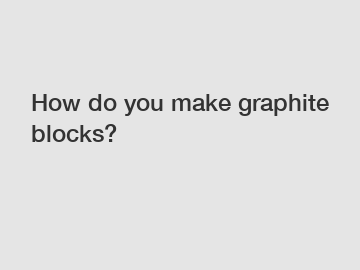How do you make graphite blocks?
Have you ever wondered how graphite blocks are made? Well, wonder no more! In this article, we'll take a closer look at the process of making graphite blocks, step by step. So grab a cup of coffee, sit back, and let's dive into the world of graphite production.
What is a graphite block?
Before we dive into the process of making graphite blocks, let's first understand what they are. Graphite blocks are solid pieces of graphite that are commonly used in various industries, such as the manufacturing of crucibles, molds, and electrodes. They are known for their high thermal conductivity, low thermal expansion, and resistance to corrosion, making them an excellent material for many applications.

Step 1: Sourcing raw materials.
The first step in making graphite blocks is to source the raw materials. Graphite is a form of carbon, and it is typically derived from natural graphite ore or synthetic graphite powder. The quality of the raw material plays a crucial role in determining the quality of the final product, so it's important to work with a reliable supplier.
Step 2: Mixing and shaping.
Once the raw materials have been sourced, they are mixed together to form a graphite paste. This paste is then shaped into blocks using a moulding process. The size and shape of the blocks can vary depending on the specific requirements of the end application.
Step 3: Curing.
After the blocks have been shaped, they undergo a curing process to remove any excess moisture and bind the graphite particles together. This is typically done in a controlled environment, such as a furnace, to ensure that the blocks are properly hardened.
Step 4: Machining.
Once the blocks have been cured, they are machined to achieve the final dimensions and surface finish. This may involve cutting, drilling, or grinding the blocks to the desired specifications. Precision machining is essential to ensure that the blocks meet the required tolerances for their intended use.
Step 5: Quality control.
Before the graphite blocks are ready for use, they undergo rigorous quality control checks to ensure that they meet the highest standards of quality and performance. This may involve testing for factors such as density, hardness, thermal conductivity, and dimensional accuracy.
Step 6: Finishing touches.
Finally, the graphite blocks are given any necessary finishing touches, such as coating or polishing, to enhance their appearance and functionality. Once this is done, the blocks are ready to be shipped to customers for use in a wide range of applications.
In conclusion, the process of making graphite blocks involves sourcing high-quality raw materials, mixing and shaping them into blocks, curing, machining, quality control, and finishing touches. It is a meticulous process that requires precision and attention to detail to ensure the production of high-quality graphite blocks that meet the needs of various industries.
If you are in need of graphite blocks for your next project, don't hesitate to contact us. Our experienced team can provide you with the highest quality graphite blocks sourced from reliable suppliers. So why wait? Contact us today and get started on your graphite block production journey!
If you are looking for more details, kindly visit block of graphite, carbon artificial graphite block, graphite blocks customized.

Comments
0